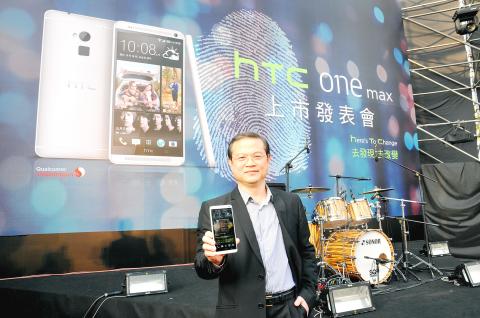Smartphone vendor HTC Corp (宏達電) yesterday said it has targeted China’s 10 most-populated cities to sell its latest One Max smartphone, which has a 5.9-inch display, in its effort to expand its Chinese market share to 20 percent.
HTC made the remarks before it launched its latest smartphone in Greater Kaohsiung yesterday.
The company said it had cleaned most of its inventories in China last quarter and that the company expected to see the One Max phablet boost sales this quarter.

Photo: Lee Chiu-ming, Taipei Times
“HTC will coorporate with Chinese telecom operators to sell its products in China’s big cities,” HTC’s Greater China operations head Jack Tong (董俊良) told reporters ahead of a product launch event.
HTC will work with China’s major mobile operators, including China Mobile Ltd (中國移動), to sell its One series flagship smartphones, Tong said.
“Then, we will gradually increase the number of our stores in second-tier cities,” Tong added.
HTC planned to increase the number of its Chinese stores to 4,000 next year from the current 3,000 stores in China’s first-tier cities, including Beijing, Chongqing and Shanghai.
HTC aims to grow its Chinese market share to 20 percent in competition with Chinese smartphone vendors, including Lenovo Group (聯想), ZTE Corp (中興), Huawei Technologies Co (華為) and Xiaomi Corp (小米), Tong said.
Leveno is the second-biggest smartphone maker in China with market share of 12.6 percent in the second quarter of this year, while ZTE and Huawei ranked No.4 and No.5 respectively, with market shares of 8.8 percent and 8.7 percent, according to IDC’s tally.
“We are determined and working hard to reach our goal,” Tong said.
HTC’s new One Max phablet will be available in Taiwan from next Wednesday at the price of NT$23,900 (US$814.68).
However, mobile users will have to pay only NT$8,990 for the phone by signing a two-year service contract with local telecoms at a monthly minimum fee of between NT$1,343 and NT$1,388, HTC said.
As One Max supports 4G LTE technology, Tong expects the phone will receive a boost from the upcoming launch of 4G services in China.
“We have seen the dawn and our hard work will pay off,” he said.
HTC’s One Max is equiped with Qualcomm Inc’s older-generation Snapdragon 600 1.7GHz quad-core processor, a less powerful processor than the Snapdragon 800 2.3GHz quad-core processor used in Samsung Electronics Co’s 5.7-inch Galaxy Note 3.
HTC also said that it aims to take at least a 50 percent share of Taiwan’s phablet market with the launch of its 5.9-inch HTC One Max, going head to head with Samsung Electronics Co’s Galaxy Note series.
The new phablet — a phone and tablet hybrid — will help HTC become the top phablet vendor in its home market, Tong said.
HTC’s shares closed up 0.76 percent at NT$133 in Taipei trading, underperforming the benchmark TAIEX, which gained 0.79 percent.
Additional reporting by CNA.

CHIP RACE: Three years of overbroad export controls drove foreign competitors to pursue their own AI chips, and ‘cost US taxpayers billions of dollars,’ Nvidia said China has figured out the US strategy for allowing it to buy Nvidia Corp’s H200s and is rejecting the artificial intelligence (AI) chip in favor of domestically developed semiconductors, White House AI adviser David Sacks said, citing news reports. US President Donald Trump on Monday said that he would allow shipments of Nvidia’s H200 chips to China, part of an administration effort backed by Sacks to challenge Chinese tech champions such as Huawei Technologies Co (華為) by bringing US competition to their home market. On Friday, Sacks signaled that he was uncertain about whether that approach would work. “They’re rejecting our chips,” Sacks

NATIONAL SECURITY: Intel’s testing of ACM tools despite US government control ‘highlights egregious gaps in US technology protection policies,’ a former official said Chipmaker Intel Corp has tested chipmaking tools this year from a toolmaker with deep roots in China and two overseas units that were targeted by US sanctions, according to two sources with direct knowledge of the matter. Intel, which fended off calls for its CEO’s resignation from US President Donald Trump in August over his alleged ties to China, got the tools from ACM Research Inc, a Fremont, California-based producer of chipmaking equipment. Two of ACM’s units, based in Shanghai and South Korea, were among a number of firms barred last year from receiving US technology over claims they have

It is challenging to build infrastructure in much of Europe. Constrained budgets and polarized politics tend to undermine long-term projects, forcing officials to react to emergencies rather than plan for the future. Not in Austria. Today, the country is to officially open its Koralmbahn tunnel, the 5.9 billion euro (US$6.9 billion) centerpiece of a groundbreaking new railway that will eventually run from Poland’s Baltic coast to the Adriatic Sea, transforming travel within Austria and positioning the Alpine nation at the forefront of logistics in Europe. “It is Austria’s biggest socio-economic experiment in over a century,” said Eric Kirschner, an economist at Graz-based Joanneum

BUBBLE? Only a handful of companies are seeing rapid revenue growth and higher valuations, and it is not enough to call the AI trend a transformation, an analyst said Artificial intelligence (AI) is entering a more challenging phase next year as companies move beyond experimentation and begin demanding clear financial returns from a technology that has delivered big gains to only a small group of early adopters, PricewaterhouseCoopers (PwC) Taiwan said yesterday. Most organizations have been able to justify AI investments through cost recovery or modest efficiency gains, but few have achieved meaningful revenue growth or long-term competitive advantage, the consultancy said in its 2026 AI Business Predictions report. This growing performance gap is forcing executives to reconsider how AI is deployed across their organizations, it said. “Many companies